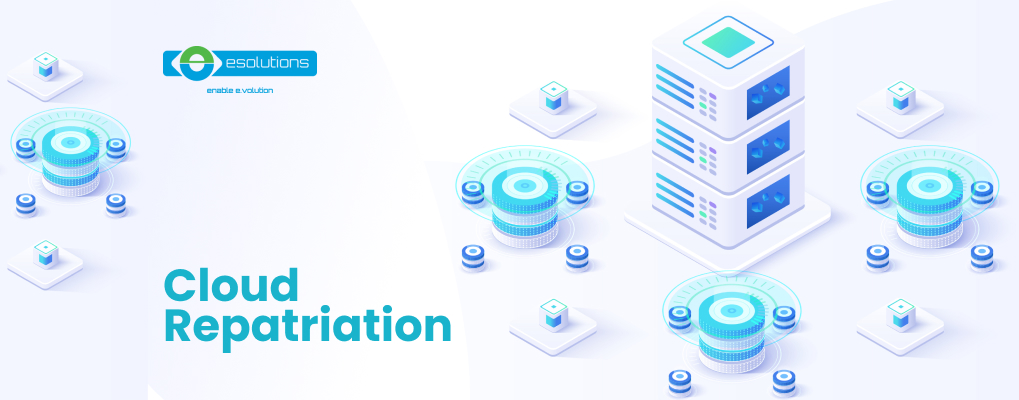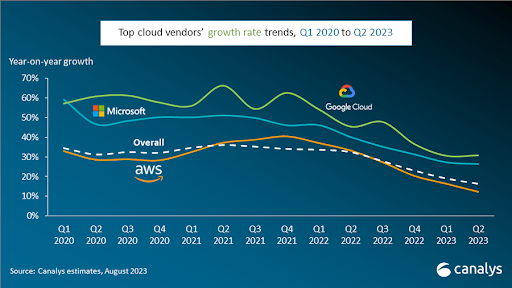
We’ve all heard in the past ten years about the long lists of benefits of moving all your data, apps, and infrastructure to the cloud. But a disruption is taking place, and companies worldwide are starting to move away from the cloud, taking their data back on-premises.
This makes cloud repatriation - as this is what this migration is called - a hot topic in 2023. Let’s discuss why it came to this, which are the challenges faced both in the cloud and in this reverse migration process, and what the future holds in terms of cloud strategies.
Cloud repatriation, also known as reverse cloud migration or cloud exit, refers to the process of moving data, apps, or workloads that were previously hosted in a cloud environment back to an on-premises infrastructure.
While the cloud market is still growing, it seems to be on a decline compared to previous quarters. A report from August 2023 from Canalys shows that worldwide cloud spending increased 16% to US$72.4 billion in Q2 2023, however the top three vendors (AWS, Microsoft Azure and Google Cloud) collectively grew 20% – down 2% from Q1.
If we look at the graph below made by Canalys, we could say that from 2020 to 2023 the overall cloud adoption and usage has been on a gradual decline:

So why do people move away from the cloud? The decision of repatriating resources from the cloud is driven by various factors ranging from cost considerations or security, to performance issues or talent shortage. Let’s take a look at some of the possible causes.
According to a survey taken by Canonical in 2022 on cloud pricing, most respondents believe that their organizations pay too much for cloud infrastructure, while they consider private cloud costs as being more predictable.
Although there are relatively low upfront costs for migrating to the cloud, specialists noticed that in the long run the monthly fees and storage costs became too high, as the workloads grew. This could be from a lack of proper planning at the beginning of a migration, overvaluing the cost savings they would get from moving to the cloud, but also from growing ingress-egress fees or data transfer fees, as they add up.
Another reason for changing preferences towards the private cloud is that executives consider private cloud costs as more predictable than the public cloud. Since on-premises infrastructure features budget stability and predictability, leaving out the fluctuations common with public cloud pricing, organizations started to pick up on this trend, perform their own analyses, and decide towards other infrastructure options. For instance, Dropbox is one of the major companies that managed to save almost $75 million from cloud repatriation.
According to the same survey by Canonical, some of the major reasons that most organizations bring when choosing to move away from the cloud are compliance, policies, and security of data, this even surpassing high costs.
This is especially common in banking or healthcare companies, where strict regulations and data sovereignty are in place for handling highly sensitive data and for keeping data in-house, but not only. It can also be a country or government regulation, or an enforced contractual obligation, and most organizations end up asking themselves whether confidential data is ultimately safe in the cloud or not.
While most cloud providers do offer healthcare and banking-specific services, they might still be at risk of non-compliance, when considering the HIPAA (Health Insurance Portability and Accountability Act) or the PCI DSS (Payment Card Industry Data Security Standard) regulations. Strict data control laws, such as the GDPR in EU, which enforces European citizens’ data to be stored on EU soil, also brought about some challenges with cloud hosting.
In another 2021 survey of UK executives by Deloitte, most CxOs mentioned compliance and regulatory requirements as the most significant barrier to cloud adoption. A more controlled environment is thus preferred when discussing data storage.
Increasingly large amounts of data are created daily and in various larger formats (see the direction of online video content for media, entertainment, or e-commerce companies). It is known that businesses that don’t make use of their data are lagging behind, so organizations are seeing multiple benefits in storing their data on private servers, since they can bypass paying for additional cloud storage, on top of the cloud subscription fees.
Cloud migrations can be done in a lift and shift model, meaning that you simply move everything as is in a cloud environment with minimal or no changes at all, or in a gradual transition, where you also update technologies, modernize apps, and optimize costs in the process.
The lift and shift model usually brings about quite a number of issues, since cloud infrastructures necessitate specific implementations, otherwise performance can be affected in the long run. Low bandwidth and high latency are common problems encountered when “copy-pasting” your infrastructure in the cloud.
As businesses are constantly looking for ways to optimize their operations and IT resources, reverse cloud migration can also allow for overviewing how workloads are distributed and function across various environments, and enhancing the processes altogether.
If organizations are opting for private clouds, then the issue of vendor lock-in disappears. In a hybrid or a multi-cloud architecture, your data is stored and processed in different places so there’s no more risk of having to keep all your business in a cloud just because all the processes are already running and optimized for that particular cloud.
Last, but not least, in Deloitte's 2021 cloud survey, 1 in 3 cloud adopters were concerned about the internal lack of capability to execute wanted digital strategies. The various cloud platforms require different skill sets - each provider has its own certifications, and finding engineers that can master all processes is close to impossible.
We’ve seen why companies are moving back in-house, however, while cloud migration is a complex process, that doesn’t mean migrating back on-premises is child’s play. Why is that?
You’ll have to have an infrastructure that can support all your data, apps, and workloads before starting the reverse migration process. Having a well-devised plan, not only for the short run, but also with scalability in mind for the long haul, can alleviate the obstacles you might encounter in the transition.
While cloud infrastructure is an on-going monthly cost, a private infrastructure requires a large up-front investment, which some companies might not have. However, if you consider the investment in the long run, an in-house infrastructure might prove more advantageous.
Using already existing hardware and considering the necessity of investing in new hardware, as well as having an infrastructure that meets the requirements of in-house data storage, should be top of mind for organizations who plan on hosting their workloads and data privately.
You’ll need a team to plan, build, and maintain your private infrastructure. That means either hiring new staff or training existing employees to have the skills needed for this new direction and for managing the data in-house.
As one of the main reasons for moving away from the cloud was security of data and regulations compliance, this need remains even when changing the infrastructure. Ensuring your teams follow security protocols and best practices, that you have backups and regular security audits, and make use of firewalls, data encryption, or other security tools is mandatory.
While any kind of change brings about various challenges, it is clear that the move to on-premises promises organizations better control, performance and security, and better outcomes for the future of their businesses, but not without its efforts.
So is cloud repatriation the opposite of a migration to the cloud? Not exactly. (Although we did mention that cloud repatriation is as complex a move as cloud migration.)
While migrating to the cloud came about as a result of companies needing to modernize their legacy systems, moving away from the cloud or cloud repatriation could also lead the way to further modernization of your systems and infrastructure towards other strategies.
Which are some of the strategies we should expect and look at in the future? At the end of the day, the end-customer is receiving the same experience, however, these changes aim at lowering costs and improving performance of the supplier’s infrastructure. There is already a preference towards a mix of public and private clouds, according to the same survey by Canonical.
Many organizations are exploring hybrid cloud settings that combine some on-premises infrastructure with specific workloads hosted in the cloud. Meanwhile, others are opting for a private cloud strategy, which provides the advantages of virtualized infrastructure in a single-tenant environment, whether it's located on-premises or in a colocation facility. However, there are some companies that want their actual cloud on-premise. And for them, AWS Outpost, Azure Stack, and Google Anthos are readily available to use, which offer on-premise hardware linked to the organization's cloud services, since cloud providers have noticed and hopped on this trend as well.
There was a high demand for a long time for Cloud Engineers and DevOps to bridge the skill gap needed in the great migration to the cloud. While most companies looked for DevOps engineers, both developers and sysadmins turned towards DevOps positions. However, in today’s trends, sysadmins turned DevOps can help with cloud repatriation more than ever, since they have the skills to work both in the cloud, but also on-premises.
At eSolutions, we boast this kind of DevOps specialists that have know-how in working on both cloud and on-premises, and we are happy to help organizations in their new infrastructure endeavors and in their efforts to continuously modernize their systems. Whether you still wish to move to the cloud and see benefits in this for your business, or you wish to migrate away from the cloud, we can support you throughout your journey.

An enthusiastic writing and communication specialist, Andreea Jakab is keen on technology and enjoys writing about cloud platforms, big data, infrastructure, gaming, and more. In her role as Social Media & Content Strategist at eSolutions.tech, she focuses on creating content and developing marketing strategies for the eSolutions’ blog and social media platforms.